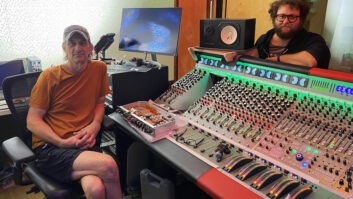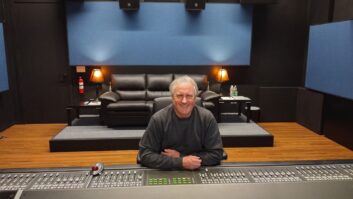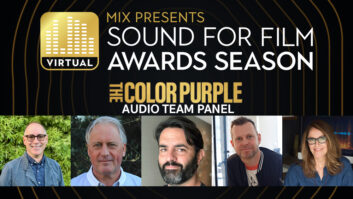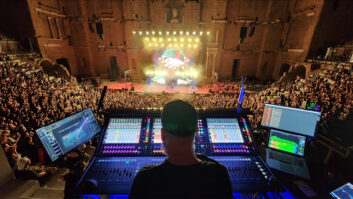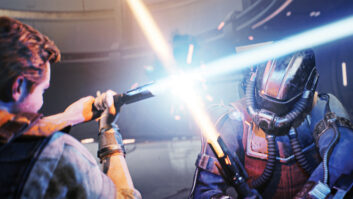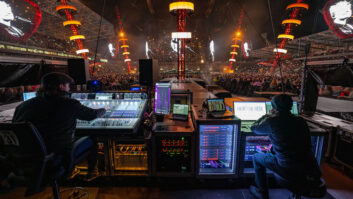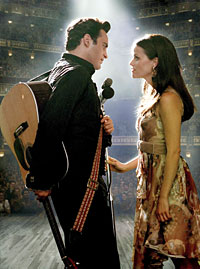

With the triumph of Jamie Foxx’s uncanny portrayal of Ray Charles still fresh in our minds, buzz in the movie industry has now turned to the lead performances in a very different music biopic: director James Mangold’s Walk the Line, a 20th Century Fox film about the tumultuous early career of Johnny Cash and his courtship of June Carter. Critics who have seen the film and the post-production crew who worked on it are raving about Joaquin Phoenix and Reese Witherspoon’s portrayals of The Man in Black and the woman who saved him from certain infamy.
Like Ray, the film offers a compelling glimpse of a music world in transition; in this case, that period when country music and R&B gracefully fused to give birth to rockabilly and rock ‘n’ roll. But unlike the Charles film, in Walk the Line, the actors do their own singing, and the musical accompaniment is fresh from Nashville and L.A. studios, not plucked from old recordings (although there are plenty of those in the form of period source music). These onscreen musical performances are all new, and while some effort was made to make them sound true to the originals, music producer T-Bone Burnett and his engineer, Mike Piersante, were not obsessive about it.
“Our job wasn’t really to re-create the original recordings,” notes Piersante, whose best known engineering work was the Grammy-winning soundtrack for O Brother, Where Art Thou?, also produced by Burnett. “Really, we were more into capturing the vibe than getting it to sound exactly the way it was.”
The first step in getting the music together for Walk the Line occurred well before filming began, at Burnett’s Electromagnetic studio in the Brentwood section of L.A. As you might expect of someone with such a keen fascination for retro sounds, Burnett’s studio is centered around an old Bushnell console (with API EQs) that resided in Sunset Sound’s Studio 1 until 1980, and he has a large selection of vintage outboard gear and — get this — analog tape machines! But during the first stage, Burnett wasn’t worrying about recording. Piersante says, “He had Joaquin and Reese come in for a sort of boot camp for several weeks, picking keys for the songs and rehearsing a lot before we went to Nashville to record.”

Supervising music editor Mark Jan Wlodarkiewicz, also known as Vordo, has worked on large and small features.
The initial tracking for the pre-records that became the basis for Walk the Line‘s music performances was done at Sound Emporium in Nashville, sans Phoenix and Witherspoon. Burnett assembled a host of fine musicians to be his “house” band, including acoustic guitar — picker Norman Blake, who had played on a number of Cash’s recording sessions and been a part of the band on Cash’s late-’60s TV show; electric guitarist Jamie Hartford (son of the multi-instrumentalist Cash pal John Hartford); bassist Dennis Crouch; L.A. drummer David Kemper (who was a member of Bob Dylan’s touring band for many years); and producer/musician Jack Clement, who actually built the studio back in 1969 and hired its current owner, Garth Fundis, as an engineer there in the early ’70s.
“Jack played some of the guitar parts where you actually stick a dollar bill in the strings and it makes this interesting sound,” Piersante says. “Plus, he knows so much about how things were done in Nashville years ago. I picked his brain quite a bit: ‘What would you have done, miking-wise, on this kind of session?’”
Sound Emporium is equipped with a Neve 8128 console, “which we used basically to monitor through,” says Piersante. “I rented some [Neve] 1081s and 1073s [mic pre’s] to record through, and used all the standard vintage compressors: Fairchild, LA-2As. T-Bone is also a stickler about vintage guitars and amps, no transistors in the path and things like that. We recorded to a Studer 24-track like we usually do; then, if you have to go to Pro Tools, which at this point you always do if you’re dealing with music for a film, at least you’ve got that sound [of the tape] on there.” Miking included Neumann U47s as drum overheads; a FET 47 on the kick; an RCA 77 ribbon mic a few feet out in front of the kit; more 77s on guitars, autoharp and pedal steel; and an old RCA 6203 Varacoustic on Blake’s guitar.
After Burnett and Piersante returned to L.A., there were still a number of pre-records to do, so they booked time at Capitol Studios’ Studio B (another Neve room) and brought in a few new players, including veteran L.A. session drummer Bill Maxwell and X guitarist Tony Gilkyson. Phoenix and Witherspoon laid down most of their vocals at Burnett’s studio, “but we also had them come down to Capitol and sing some things live [with the band],” Piersante says. “Also, there’s a guy who plays Roy Orbison [Jonathan Rice] and one who plays Jerry Lee Lewis [Waylon Payne], and we had them come in and do live vocals with the band — that was great!” (A soundtrack album with many of the performances from the film comes out on November 15.)

The Nashville crew at Sound Emporium, from left: David Ferguson,
Norman Blake, Jamie Hartford, Dennis Crouch and Jack Clement
Burnett also created the moody original score for Walk the Line, for which he and Piersante went into The Village in West L.A. with a small ensemble — guitarists Bill Frisell and Marc Ribot and drummer Jim Keltner — and laid down tracks for the different cues, usually working to picture. Burnett occasionally played guitar, too, and keyboardist Keith Ciancia added some atmospheric touches. Frank Wolf was later brought in to mix the score. Music editors Terry Delsing and Bunny Andrews worked with Burnett and Piersante in preparing those tracks for later use in the mix.
The supervising music editor for the film was Mark Jan Wlodarkiewicz (pronounced vor-dar-kay-vich, but everyone calls him “Vordo”), whose 15-year career in the San Francisco Bay Area and L.A. includes music editing on a host of large and small features, including The Mothman Propehicies and Shrek 2. One of his first major tasks on the film was to take the pre-records, which had been transferred from 2-inch to Pro Tools at 96k, and make L/C/R stems that could be used in the temp mix. “We wanted to be able to spread it out a little bit,” Vordo says, “and not just go for a mono sound on the music. At that point, too, I was using various plug-ins to get the Johnny Cash slapback vibe and other effects, but we knew we were probably going to work on that area [before the final].”
WORLDIZING THE TRACKS
One of the greatest challenges, Vordo says, was dealing with the many scenes in which live music is heard as essentially secondary sound: coming through walls, in an alleyway outside a club, backstage at a venue, etc. Re-recording mixer Paul Massey (an Oscar nominee for Master and Commander two years ago) notes, “It became apparent during the first temp mix, which I did with Mark, that we shouldn’t try to artificially recreate this music though walls with EQ and filters and the normal stuff, but that we should get it recorded in different environments. So Mark took a portable Pro Tools rig and went to various locations and recorded the music in different perspectives.”
“We did an extensive amount of ‘worldizing,’” Vordo explains. “That’s a concept that I think goes back to Apocalypse Now. In this case, I made a map of all the music in the film and tried to figure out where things played. Sometimes music is playing backstage, sometimes you’re right up front [facing the band] and then there are specialty things, like at the very beginning of the movie, you’re in Folsom Prison and the music is reverberating all through the space. When we were temping the film, the digital reverbs felt too processed, and since we had the time and energy, it was worth trying to create some verisimilitude by putting the sound in real spaces.
“So I convinced Fox [where the film was mixed, at the John Ford Theatre on a Neve DFC] to let me have the run of the whole studio for a day: the parking garage, the scoring stage and the dubbing stages. I’m also sort of a part-time DJ and I own a pretty good self-powered Mackie P.A. — with SRM 450s — and I brought it down from the Bay Area. So I put the P.A. on a rolling cart, then we took a Pro Tools rig that was also on wheels — a MIXPlus system — and I had a little Behringer mixer and then played the split [L/C/R] music tracks through the system in various environments and recorded it with a pair of Neumann KM 140s. We recorded through an Apogee Trak2 and a little digital recorder.”

Engineer Mike Piersante (left) and Jack Clement
Helping Vordo were a trio of friends: music editors Erich Stratmann and Nancy Tracy and picture editor Jeff Ford. “It was like one of those Huck Finn moments where everyone came out of the woodwork to help,” Vordo says with a laugh. “We started at the scoring stage at Fox, which sounded really good.” Rather than just using the ambience of the big room, however, “we used it like a big speaker,” by putting the recording rig in the alley next to the stage, opening the doors to the stage and capturing the music “as it slapped around the alley. That was wonderful.
“For the source tracks that we knew were going to play backstage,” Vordo continues, “we went to the Hawks Theater and had the P.A. blasting in there and had the mic sitting right outside the closed door. Another place we used was a parking structure, which was amazing. We were there on a Sunday afternoon, so there were very few cars around. We’d record [the music] from different levels, and we also went out to the grassy knoll where people have lunch 600, 700 yards away. That was truly ambient sound. Not a lot of that got used, but a little did.”
“Sometimes a band mix was what we needed,” Massey offers. “I used the original mixes that Mike and T-Bone provided and then added various degrees of the worldized tracks that Mark had provided on various instruments. The Folsom Prison scene was extremely reliant on the worldized tracks — it’s a huge reverberant environment. I also did the normal things a mixer would do in terms of low-end support, top-end reduction, and reverbs and delays and such. But the worldized tracks hopefully gave it a very unique and realistic feel. During the actual concert performances, having the flexibility from Mike and T-Bone to vary the levels, EQs, panning and reverbs and such on each individual instrument was extremely beneficial — just slightly coloring and changing the perspectives of the mix as the shot required.”
Doug Hemphill (also Oscar-nominated in 2003 for Master and Commander), who mixed effects for the film, notes that director Mangold is quite interested in sound. “He will let you bring to the table your abilities and opinions, but he is very specific about the sound; we get a lot of direction.”
What sort of suggestions would he make? “It usually has to do with supporting the story,” Hemphill says. “For instance, in the beginning, in the prison, Jim was very specific about the crowd — he wanted it to sound like a place that is about to explode because it’s a very dangerous place. So Johnny Cash is playing his music, but the prison crowd is on the verge of losing control and that dramatic element was an important sound statement for Jim.

Worldizing the music tracks at the Fox scoring stage meant playback in the room, with recording done in the alley.
“Crowds are always tough when I work on a film with music, and that was the case here, too,” he adds. “There are times when [Cash’s] career is starting out and the crowds are rowdy, small crowds in small towns and they have to have a certain feel to them. Then, as he gets more popular, the crowds become more respectful, so there’s a big range there. One good thing, though, is that the musical performances are so strong that when I mixed the crowds, I didn’t need to bolster them. You feel the song and add a few [audience] accents to it, but [the crowd] doesn’t dominate it unnaturally.” Hemphill and sound designer Ted Caplan, working under supervising sound editor Donald Sylvester, assembled the different crowd ambiences, working from a combination of production material (Peter Kurland was the location mixer), some group ADR and even some library material of crowds.
Hemphill also brought in a piece of gear that ended up being important to the finished soundtrack: a Fulltone TubeTapeEcho, or TTE, which is a modern version of a classic tape delay unit like an Echoplex. “It got used on a lot of the vocals on the film,” he says. “It’s this Luddite device — it’s analog, running at 15 ips, but it’s got a great sound.”
“It gave us the analog distortion we needed,” Massey adds, “and it worked well to give us the slapback feel that was so important to the music of that time.”
There was also a considerable amount of source music used — coming out of radios, jukeboxes and the like — and the task of choosing those songs fell mostly to Vordo, who immersed himself in every relevant period recording he could find, and was aided considerably by picture editors Mike McCusker and Quincy Gunderson, director Mangold and Burnett.
“Unfortunately, there were a lot of things we wanted to use but couldn’t afford,” Vordo says. “So we had the interesting challenge of finding things that were inexpensive that fit the time and place.”
In the end, some of the best-fitting tunes were the most obscure: Instead of Gene Vincent’s “Be-Bop-a-Lula” used as temp music in one scene, Vordo found a great track by the relatively unknown Billy Lee Riley (for whom Jerry Lee Lewis once played piano) called “Rock With Me Baby.” When songs by Eddy Arnold and Bob Wills proved too expensive ($50,000?!) for a key scene between Cash and Carter in a diner, Vordo found “Defrost Your Heart” by Sun rockabilly pioneer Charlie Feathers “that was perfect for the quiet, emotional space between the characters,” he says. “It was very delicate. Jim [Mangold] wanted it to have impact, but he didn’t want it to feel ‘scored’ because it would feel disingenuous.”
Mangold’s clear and decisive direction obviously impressed the post crew, but it wasn’t always business on the stage. As Hemphill notes, “There was also a lot of music being played. We had a bunch of guitar players and musicians [working on the film], and Del Breckenfeld from Fender supplied guitars for the movie and the stage. Jim plays banjo and guitar. It was a trip and really an extension of the work we were doing on the film. People were really inspired.”

Click here to read the “Classic Track” on Cash’s “Folsom Prison Blues.”






